45 Pink Flowering Trees (With Pictures): Identification Guide
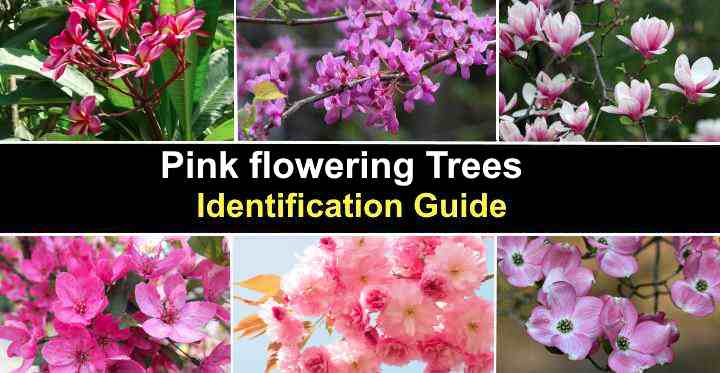
Pink flowering trees are a great way to add a splash of color and vibrancy to make any garden landscape beautiful. Trees with stunning pink blooms can create a focal point or provide a backdrop for other plants. Some trees with pink flowers have large cup-shaped blossoms, whereas others have clusters of small pink flowers. Whether you have a small or large garden, pink flowering trees are suitable for any space.
With their delicate pink blooms and lush foliage, pink-flowering trees enhance the beauty of outdoor spaces. The best ornamental trees with pink flowers are redbud, crape myrtle, dogwood, magnolia and cherry blossom trees. Other large pink-flowering trees for shade include horse chestnut trees and buckeye trees.
This article is an identification guide to pink flowering trees. Descriptions and pictures of different species of pink flowering trees will help you choose the best tree to add vibrant pink blooms to your garden landscape.
Pink Flowering Trees (With Pictures): Identification Guide
Eastern Redbud (Cercis canadensis)
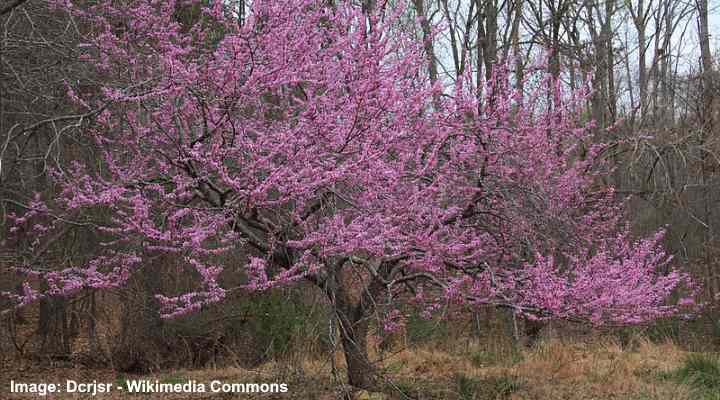
The eastern redbud tree is a small deciduous tree known for its stunning clusters of bright pink or purple flowers. The pink flowers create a striking floral display when they bloom in early spring on bare branches. The tree’s heart-shaped leaves are vibrant green and turn yellow in the fall.
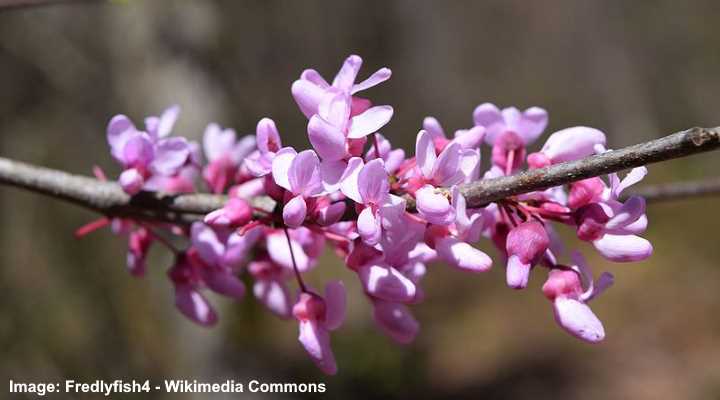
A close up picture of eastern redbud flowers
Eastern redbud trees are adaptable, thriving in various soil types. They add color and beauty to gardens, serving as popular ornamental trees. With their unique branching habit and rounded crown, they make stunning specimen trees and shrub borders. In early spring, Eastern redbuds attract pollinators, enhancing the ecological value of the landscape.
Mature Size: 20 to 30 ft. (6 – 9 m) tall and 25 to 35 ft. (7.5 – 10.5 m) wide
USDA Hardiness Zones: 4 to 9
Sun: Full sun to partial shade
Western Redbud (Cercis occidentalis)
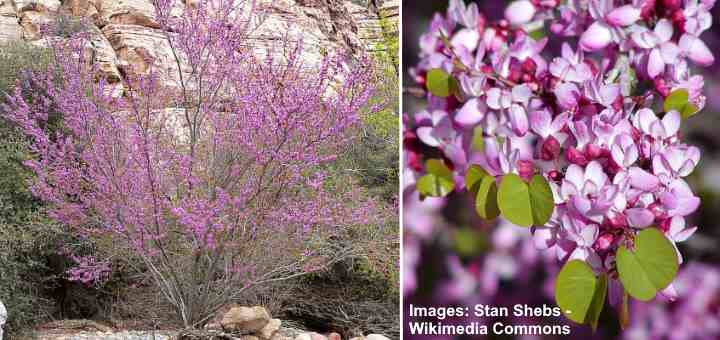
The western redbud is a stunning pink-flowering deciduous tree with an open, rounded form and heart-shaped leaves. The spectacular display of pink flowers occurs in early spring when the redbud blooms. The long-lasting flowers appear before the leaves. The redbud’s fall foliage is golden yellow or rusty red.
Western redbud provides four-season interest in residential gardens. After the pink flowers stop blooming, long purple-brown seed pods appear. The tree’s compact, irregular branching habit provides an attractive silhouette in winter. Western redbuds perform well as small, multi-trunked specimen trees in gardens with limited space.
Western redbud trees are adaptable and can thrive in a variety of soil types. They are drought-tolerant once established and are relatively low-maintenance.
Mature Size: 10 to 15 ft. (3 – 4.5 m) tall and wide
USDA Hardiness Zones: 6 to 9
Sun: Full sun to partial shade
Crape Myrtle (Lagerstroemia indica)
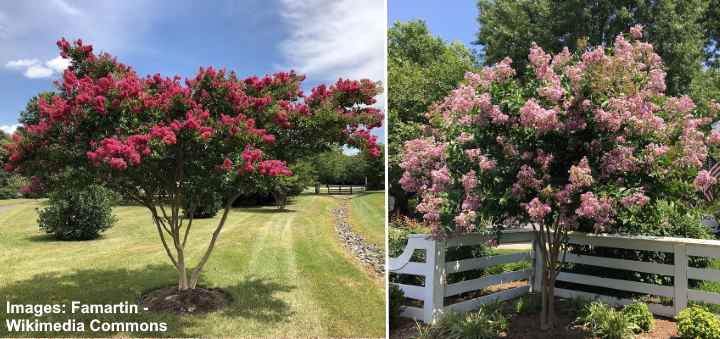
Crape myrtle trees are known for their abundant clusters of showy, fragrant pink flowers in various shades, depending on the cultivar. The showy flowers form cone-like clusters and bloom in summer, lasting several weeks. The tree’s oblong leaves are leathery, dark green blades and change to shades of orange, red, and purple in the fall.
Crape myrtle trees thrive in various landscape settings as eye-catching pink-flowering ornamental trees. They also grow as large shrubs, screens, or informal hedges. For best results, plant crape myrtle trees in loamy or clay soils with good drainage. They are also drought-tolerant and low-maintenance when established.
Due to their tolerance to heat and humidity, crape myrtle trees are sometimes called the Lilac of the South.
Mature Size: 6 to 25 ft. (1.8 – 7.6 m) tall and up to 20 ft. (6 m) wide
USDA Hardiness Zones: 7 to 9
Sun: Full sun
Pink Flowering Dogwood (Cornus florida ‘Rubra’)

You can identify the pink-flowering dogwood by its stunning pink flowers that bloom in early spring. The five pink bract-like petals surround a cluster of tiny green flowers. After flowering, orange-red fruits appear in summer. The dogwood tree’s green leaves are ovate, slightly twisted, and turn vibrant shades of red in the fall.
Pink flowering dogwood trees have four-season interest in sunny or partially shaded gardens. Its ornamental value throughout the year is from its pink flowers in spring, a dense rounded canopy of green leaves and red fruits in summer, red colors in the fall, and eye-catching alligator-like bark visible in winter.
You can plant pink-flowering dogwoods as ornamental trees in compact landscapes.
Mature Size: 15 to 30 ft. (4.5 – 9 m) tall and wide
USDA Hardiness Zones: 5 to 9
Sun: Partial shade
Pink Flowering Japanese Dogwood Tree (Cornus kousa ‘Rutpink’ and ‘Miss Satomi’)
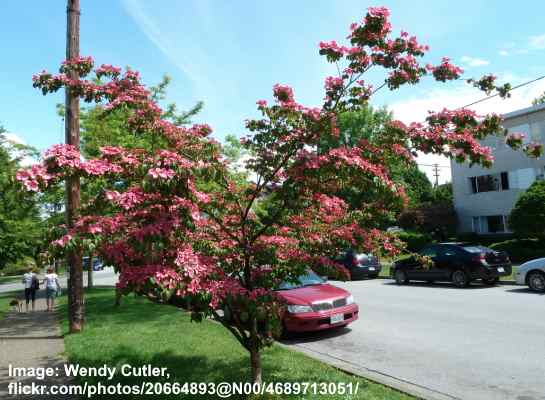
Japanese dogwood trees have showy pink flowers growing on a rounded or vase-shaped canopy. The clusters of pink star-shaped flowers appear with elliptical-shaped leaves. After flowering, small berry-like pinkish or pale red fruits appear, attracting birds and wildlife. Dogwood trees are also known for their graceful branching pattern.
The two most spectacular varieties of Japanese dogwoods are Cornus kousa ‘Rutpink’ and Cornus kousa’ Miss Satomi.’
Pink Flame Kousa Dogwood (Cornus kousa ‘Rutpink’): The dogwood is identified by its clusters of star-shaped pink flowers, reddish-purple fall foliage, and exfoliating bark. It grows 20 – 25 ft. (6 – 7.5 m) tall in full sun or partial shade in USDA zones 5 to 8.
Kousa Dogwood’ Miss Satomi’: Identifying features are its clusters of four-petalled pink flowers, rosy-pink summer fruits, bright red fall foliage, and mottled, tan bark that peels in winter. The decorative tree grows 12 to 15 ft. (3.6 – 4.5 m) tall in full sun in USDA zones 5 to 8.
Saucer Magnolia (Magnolia x soulangeana)

Saucer magnolia is a deciduous tree renowned for its abundant showy displays of fragrant pink flowers. Also called tulip magnolia for its large goblet-shaped pink and white flowers, saucer magnolia looks stunning in bloom during spring. The heat-loving magnolia tree also has green, obovate foliage that turns golden brown in the fall.
The saucer magnolia is a multi-stemmed tree with a rounded shape. Popular in ornamental gardens, the tulip magnolia performs well as a specimen tree, lawn tree, or accent tree. Magnolias prefer well-drained soil and full sun to partial shade. The saucer magnolia adds a touch of elegance and beauty to any landscape.
Do you need a small pink-flowering tree for a compact garden? If so, the small saucer magnolia ‘Lilliputian’ is ideal for small yards. This compact multi-stemmed tree grows 10 to 12 ft. (3 – 3.6 m) tall and features pale pink showy flowers.
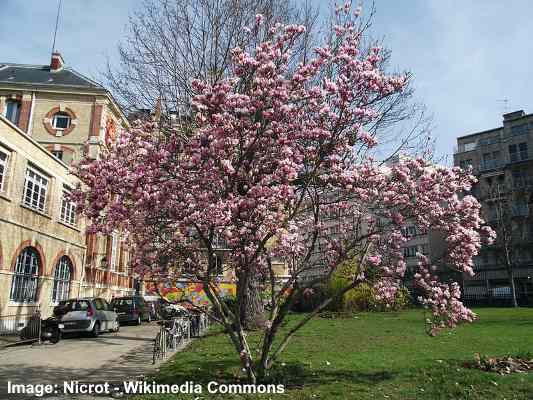
Saucer Magnolia ‘Lilliputian’ (Magnolia soulangeana ‘Lilliputian’)
Mature Size: 15 to 20 ft. (4.5 – 6 m) tall and wide
USDA Hardiness Zones: 6 to 9
Sun: Full sun to partial shade
Black Lily Magnolia (Magnolia liliiflora ‘Nigra’)
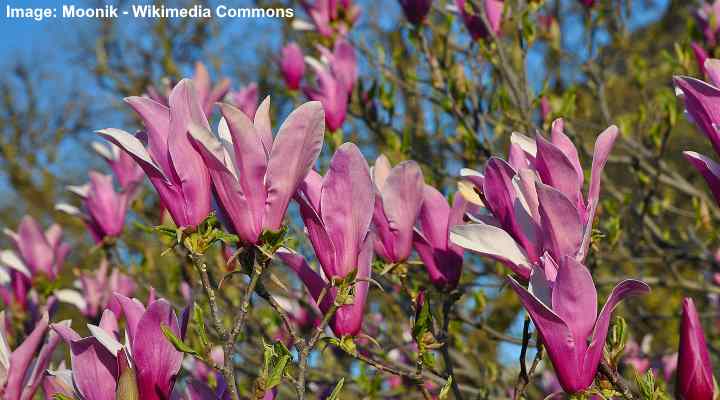
The black lily magnolia is a small tree known for its large, dark pink to purple, lily-like flowers. The highly fragrant pink flowers bloom in late spring and sporadically throughout the summer. The tree’s glossy, dark green leaves provide a beautiful backdrop to the vibrant flowers. Its large upright flowers measure 5” (12 cm) long.
Black lily magnolias are relatively small trees, making them suitable for compact front or backyards. The vibrant spring blooms enhance the aesthetics of any garden landscape. They are suitable for cottage gardens, city gardens, or as a focal point on a lawn. They prefer well-drained, slightly acidic soils.
Mature Size: 8 to 12 ft. (2.4 – 3.6 m) tall and wide
USDA Hardiness Zones: 5 to 9
Sun: Full sun to partial sun
Pink Peacock Flower (Caesalpinia pulcherrima ‘Rosea’)

The pink peacock flower is a spectacular small ornamental tree with clusters of beautiful pink-reddish flowers. The flowers have long, thin stamens emerging from bowl-shaped blossoms giving the flowers a distinctively exotic appearance. The tree’s foliage is equally impressive, with its beautiful fern-like leaves contrasting with brown seed pods.
Pink peacock trees are relatively small, making them suitable for smaller gardens or accent trees in larger yards. Its spine-covered branches make the tree a good security solution for planting as a hedge, privacy screen, or foundation planting. The tree’s vibrant pink flowers make it a popular choice for adding color and visual interest to a garden.
Mature Size: 10 to 15 ft. (3 – 4.5 m) tall and 6 to 12 ft. (1.8 – 3.6 m) wide
USDA Hardiness Zones: 9 to 11
Sun: Full sun
Kanzan Cherry Tree (Prunus serrulata ‘Kanzan’)
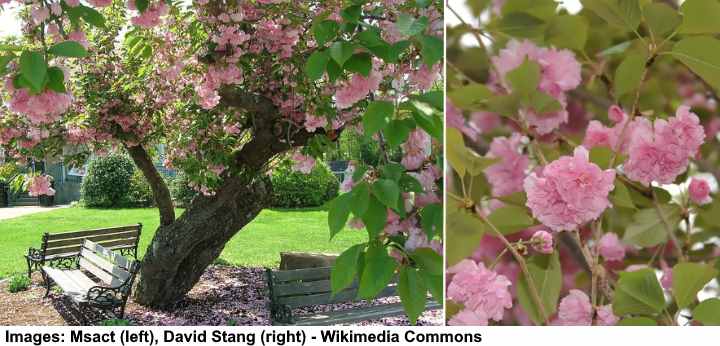
The Kanzan cherry tree is a beautiful blossom tree recognized for its stunning display of double pink flowers. The flowers, with ornamental ruffled petals, appear in densely packed clusters creating a vibrant and eye-catching spring display. The cherry blossom tree’s dark green leaves have serrated edges and turn orange or bronze in the fall, adding to its seasonal interest.
Kanzan cherry trees are relatively low-maintenance and can adapt to various soil conditions. They are commonly used in landscapes as ornamental trees to provide a burst of spring color and beauty. The tree’s compact size makes it suitable for smaller gardens as a shade tree.
Mature Size: 3 to 30 ft. (1 – 9 m) tall and 25 ft. (8 m) wide
USDA Hardiness Zones: 5 to 9
Sun: Full sun
Higan Cherry Tree (Prunus × subhirtella)

The Higan cherry tree is one of the most stunning ornamental trees with pinkish-white flowers.
The fragrant 10-petalled cup-shaped flowers bloom in beautiful clusters, adding a splash of color to spring landscapes. Other ornamental features of the Higan cherry tree are its pink flower buds, sharply toothed, deep green leaves and pea-sized black fruits. The tree’s foliage color is yellow or reddish-orange.

The Higan cherry tree is small and adaptable to various well-drained soil types. The masses of pink spring blooms make the tree a good lawn tree or create a focal point. Additionally, its tolerance for urban environments means the beautiful blossoms enhance the aesthetics of city gardens.
Mature Size: 20 to 30 ft. (6 – 9 m) tall and 15 to 30 ft. (4.5 – 9) wide
USDA Hardiness Zones: 6 to 8
Sun: Full sun to partial shade
Weeping Cherry Trees (Prunus pendula)
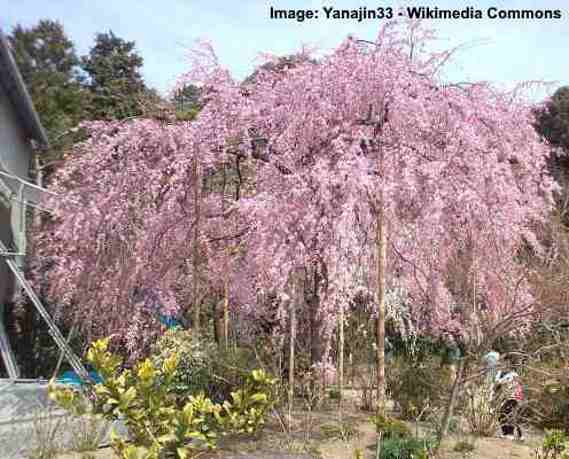
Weeping cherry trees are elegant ornamental trees with pale pink or pinkish-white flowers. The flowering trees are prized for their graceful weeping habit and cascading foliage. The weeping cherry blossom trees have glossy green leaves that turn vibrant shades of yellow, orange, or bronze in the fall, along with pea-sized black fruits.
Weeping cherry trees burst into breathtaking displays of cascading flowers in springtime. You can plant a pink blossom weeping cherry tree to create a focal point in gardens. In addition to their stunning pink flowers, the trees emit a pleasant fragrance, adding to their overall landscaping appeal.
Mature Size: 15 to 25 ft. (4.5 – 7.5 m) tall and wide
USDA Hardiness Zones: 6 to 8
Sun: Full sun
Cherry Blossom Tree ‘Pink Perfection’ (Prunus serrulata ‘Pink Perfection’)

The cherry blossom cultivar ‘Pink Perfection’ is a stunning small ornamental tree with abundant clusters of fragrant pink flowers. Bright double-pink flowers cover the tree in late spring. Each pink blossom has around 30 ruffled petals. The cherry blossom tree’s twisted branches produce leaves that turn vibrant red and orange in the fall.
‘Pink Perfection’ cherry blossom trees are small in size. The decorative trees are suitable for smaller landscapes, such as lawn trees or specimen plants. Additionally, they perform well in containers to brighten a patio or deck area.
With their three-season beauty of flowers, fruits, and unique branching habit, ‘Pink Perfection’ cherry blossom trees are a beautiful addition to any garden.
Mature Size: 10 to 15 ft. (3 – 4.5 m) tall and up to 12 ft. (3.6 m) wide
USDA Hardiness Zones: 6 to 8
Sun: Full sun
Yoshino Cherry Tree ‘Awanui’ (Prunus x yedoensis ‘Awanui’)

The Awanui Yoshino cherry tree is a stunning medium-sized pink-flowering tree with masses of fragrant pale flowers blooming in spring. The almond-scented single pink flowers bloom in clusters, creating a breathtaking floral spectacle that attracts birds and pollinators. The tree’s bloom time is two to three weeks. After blooming, vibrant green leaves appear along with clusters of shiny black drupes.
With their soft pink flowers, Awanui Yoshino cherry trees are relatively low-maintenance ornamental trees that tolerate many soil types. The tree’s dense foliage creates shade in temperate landscapes during summer. Additionally, it grows well as a specimen plant or lawn tree.
Mature Size: 20 ft. (6 m) tall and 26 ft. (8 m) wide
USDA Hardiness Zones: 5 to 8
Sun: Full sun
Pink-Flowering Crabapple Trees

Pink-flowering crabapple trees are famous for producing beautiful pink blooms in the spring. The attractive fruit tree blossoms in various colors, from soft pinks and rosy shades to deeper pinks. The pink flowers can be single, semi-double, or double, with double flowers creating fragrant, showy floral displays.
Crabapple trees are ideal for adding pink colors to spring gardens. After the pink blossoms, dark green leaves cover the irregular canopy before small cherry-like pomes appear on twisted branches. You can also plant the small trees in rows to create an informal hedge or flowering border.
Here are some varieties of crabapples with pink flowers:
Crabapple Malus ‘Robinson’ – ‘Robinson’ crabapples are prized decorative flowering landscape trees due to their showy pink flowers. ‘Robinson’ crabapples are suitable for growing in zones 4 through 8. The tree grows 15 to 25 ft. (4.5 – 7.6m) in height and spread.
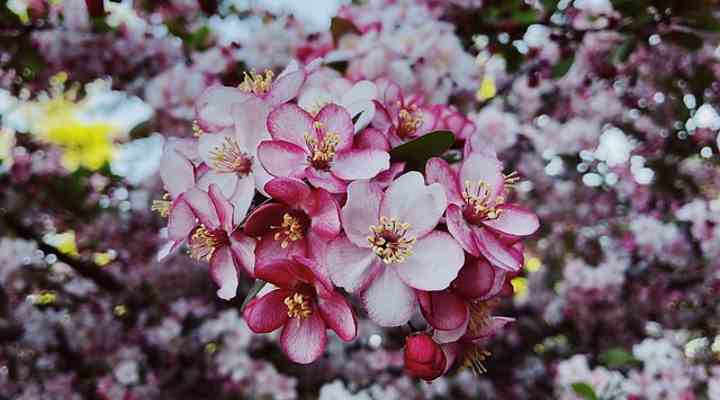
Robinson crabapple
Crabapple Malus ‘Pink Spires’: This variety features a narrow, columnar growth habit and abundant deep pink blossoms. The flowers appear in spring and create a stunning vertical display.
Crabapple Malus ‘Brandywine’ – ‘Brandywine’ crabapple trees have showy flowers consisting of pink double blooms. The flowers appear in mid-summer along with bright cherry-red leaves. ‘Brandywine’ crabapple trees grow between 15 and 20 ft. (4.5 – 6 m) tall with a spread of up to 20 ft. (6 m).
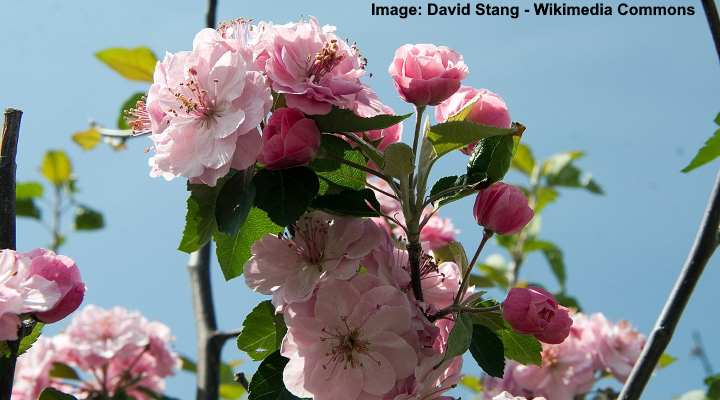
Brandywine Crabapple
Crabapple Malus ‘Pink Perfection’: Known for its exceptionally large, double pink flowers, this variety creates a show-stopping floral display. The flowers are fragrant and emerge mid-spring, adding beauty and fragrance to the landscape.
Crabapple Malus ‘Royal Raindrops’ – A delightful flowering tree with an abundance of magenta-pink flower clusters. The upright crabapple tree has a broad, round crown that is colorful for most of the year. Royal Raindrops’ crabapple trees grow to between 15 and 20 ft. (4 – 6 m) tall with a spread up to 15 ft. (5 m) in zones 4 to 8.
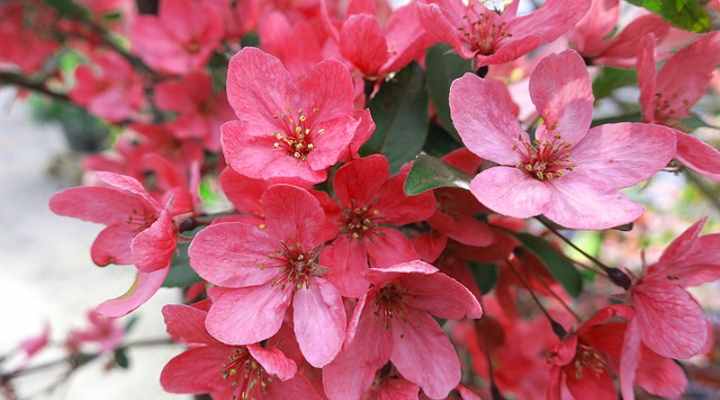
Royal Raindrops crabapple
Crabapple Malus ‘Pink Princess’: With semi-double pink flowers, ‘Pink Princess’ is a compact crabapple tree with a profusion of blooms. It has an attractive, rounded form and is an excellent choice for smaller gardens or spaces.
Crabapple Malus ‘Louisa’ – A small weeping crabapple tree with pastel pink-colored blossoms. Flowers appear on this crabapple variety in the middle of spring. The clusters of flowers on the drooping branches make the ‘Louisa’ crabapple highly ornamental. ‘Louisa’ crabapples grow between 12 and 15 ft. (3.6 – 4.5 m) tall.
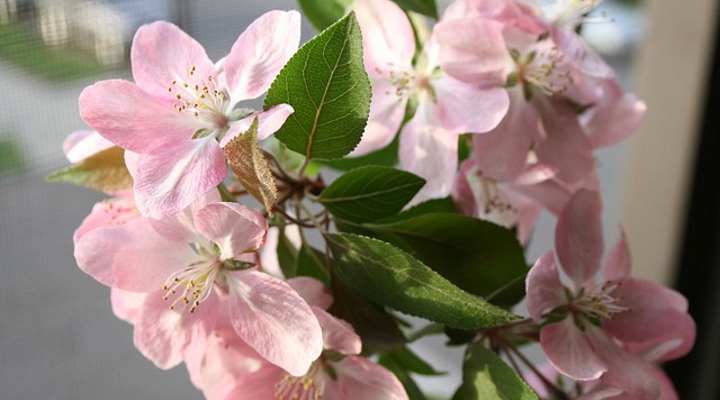
Crabapple Louisa
Crabapple Malus ‘Prairifire’: ‘Prairifire’ crabapple offers bright pinkish-red flowers that cover the tree in spring. The flowers are followed by small dark red fruits that persist into winter, providing additional interest.
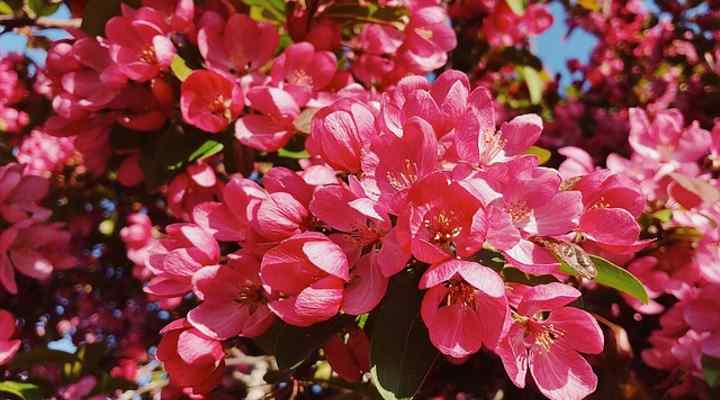
Prairifire crabapple
Crabapple Profusion (Malus x moerlandsii) – Crabapple ‘Profusion’ flowers are clusters of deep pink, fragrant flowers that bloom in mid-spring. The large crabapple trees grow between 15 and 30 ft. (4 – 9 m) tall with a massive spreading crown of 35 ft. (10 m) wide.
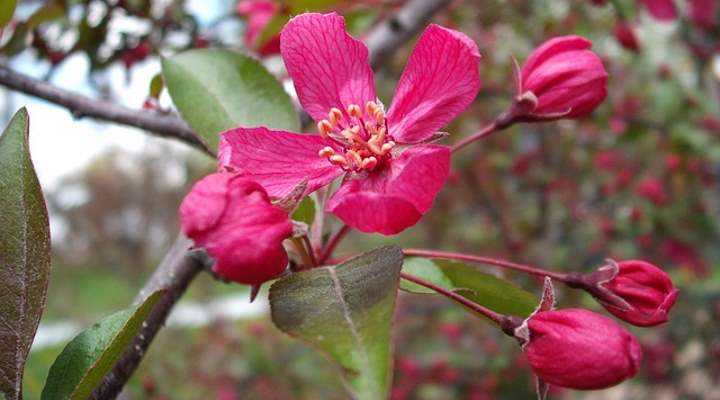
Crabapple Profusion (Malus x moerlandsii)
Sweet Crabapple or Wild Crabapple (Malus coronaria) – The sweet crabapple tree has pinkish-white flowers that emit a pleasant fragrance. The juicy edible flesh has a distinctive sour taste. Wild crabapples grow as large flowering shrubs or small-medium trees. The tree grows up to 33 ft. (10 m) tall and has a broad, spreading crown.
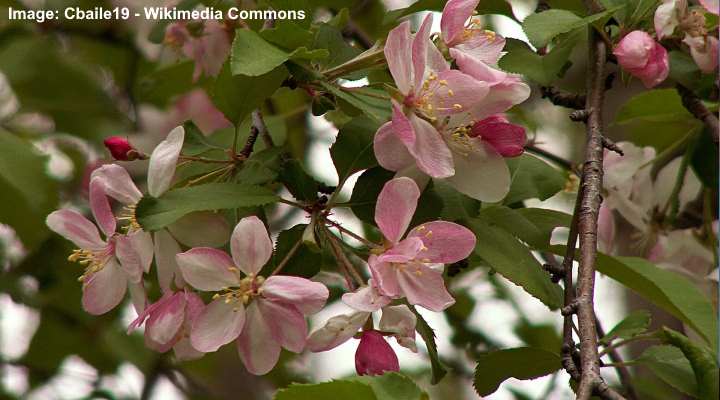
Sweet Crabapple or Wild Crabapple (Malus coronaria)
Red Horse Chestnut (Aesculus carnea)
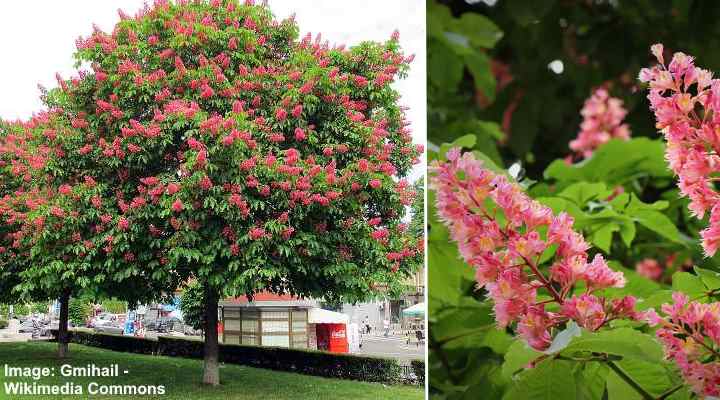
The red horse chestnut tree is a stunning shade tree known for its clusters of bright rose-red and pink flowers. Blooming in late spring, the vibrant pink flowers grow in upright conical clusters, giving them a striking appearance against the tree’s dark green foliage. The deciduous tree has no significant fall colors.
Red horse chestnut trees are medium sized, making them suitable for a variety of landscapes. You can use them as shade trees or specimen trees in larger yards or park settings.
In addition to its cone-like pink flower clusters, the red horse chestnut is identified by its spiny capsules that contain shiny brown nuts.
Mature Size: 30 to 40 ft. (9 – 12 m) tall and wide
USDA Hardiness Zones: 5 to 8
Sun: Full sun or partial shade
Orchid Tree (Bauhinia variegata)
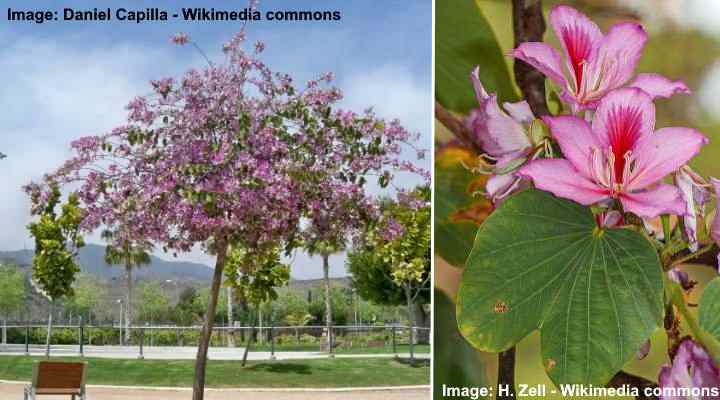
The orchid tree is a great choice if you want an exotic tropical tree with pink flowers. Known for its stunning pink flowers that resemble orchids, the tree has a spreading canopy, light green leaves resembling butterfly wings, and long, sharp-beaked seed pods. In the warmest regions, the tree’s foliage is evergreen.
Orchid trees are popular ornamental trees due to their striking tropical flowers. They prefer well-drained, moist soil and are drought-tolerant. You can grow the attractive tree as a specimen tree, in small groups, or as part of a mixed border.
Mature Size: 20 to 35 ft. (6 – 10.5 m) tall and wide
USDA Hardiness Zones: 9 to 11
Sun: Full sun to partial shade
Hong Kong Orchid Tree (Bauhinia × blakeana)
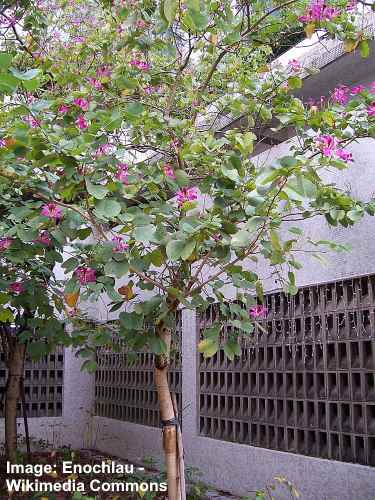
The Hong Kong orchid tree is recognized by its stunning orchid-like flowers that bloom profusely from fall through spring. The large, showy, fragrant flowers are a vibrant shade of pink or purple with arching creamy-white stamens. The unique leaves are two-lobed and resemble butterfly wings. When in bloom, the flower clusters cover the tree, creating a breathtaking display.
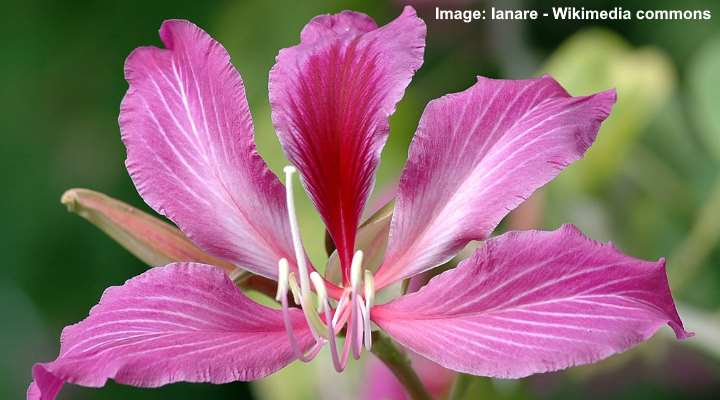
A close up picture of Bauhinia blakeana flower
Hong Kong orchid trees thrive in warm, sunny landscapes. They have an umbrella-shaped canopy of gray-green heart-shaped leaves. However, the pink flowers are showstoppers—considered by many to be the most attractive flowers in the world. You can plant an orchid tree as a focal point in gardens.
Mature Size: 12 to 20 ft. (6 – 12 m) tall and wide
USDA Hardiness Zones: 9 to 11
Sun: Full sun
Desert Willow (Chilopsis linearis)
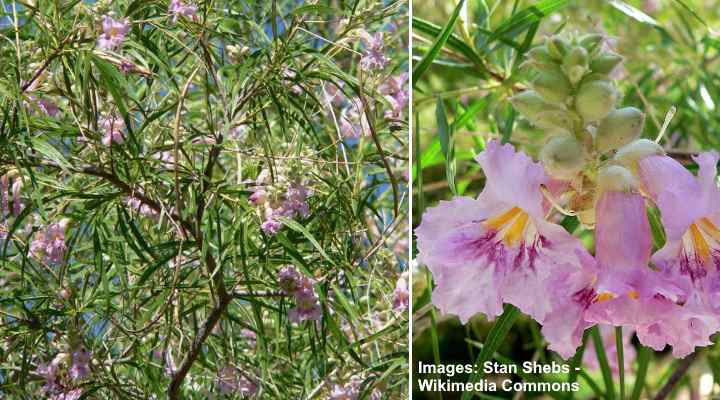
Desert willow is a small deciduous tree known for its beautiful pink flowers with dark pink and purple streaks. The trumpet-shaped flowers bloom in large clusters and have a sweet fragrance. After blooming from late spring through fall, the tree produces long bean-like seed pods. The tree leaves have a long, narrow, pointed shape giving it a graceful appearance.
Desert willow trees are fast-growing and drought-tolerant, thriving in hot, dry climates. They are a popular choice for xeriscapes and desert gardens. The tree’s unique beauty and ability to attract hummingbirds and butterflies make it a great addition to any landscape as a lawn tree or a specimen plant.
Mature Size: 15 to 30 ft. (4.5 – 9 m) tall and wide
USDA Hardiness Zones: 7 to 11
Sun: Full sun
Pink Trumpet Tree (Handroanthus heptaphyllus)
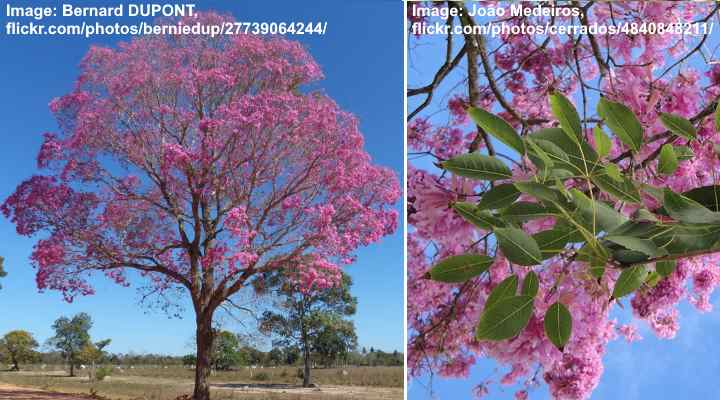
The pink trumpet tree stands out in landscapes with its stunning display of vibrant pink trumpet-shaped flowers. The clusters of pale to deep pink tubular flowers appear in spring and last several weeks. The flowers cover the tree with a stunning pink canopy. The tree’s palmate compound leaves are dark green and have serrated margins.
Pink trumpet trees are native to tropical and subtropical regions of South America. The decorative trees thrive in well-drained clay, loam, and sandy soils. They add a burst of pink colors to large garden landscapes.
Mature Size: 40 to 50 ft. (12 – 15 m) tall and 35 to 50 ft. (10 – 18 m) wide
USDA Hardiness Zones: 10 and 11
Sun: Full sun or partial shade
Rosy Trumpet Tree (Tabebuia rosea)

The rosy trumpet tree produces eye-catching lavender-pink tubular flowers with yellow throats. It’s a deciduous tree with tropical trumpet-shaped flowers ranging in color from light pink to deep magenta. The flowers bloom in clusters, covering the tree in a stunning display of color.
In addition to its vibrant pink flowers, the rosy trumpet tree has green, glossy compound leaves and long, slender seed pods measuring up to 14” (35 cm) long.
Rosy trumpet trees prefer deep, fertile soil that drains well but holds moisture. The trees are low-maintenance and drought-tolerant once established. You can plant rosy trumpet trees for shade in large tropical and subtropical regions to add a splash of color to your gardens.
Mature Size: 60 to 90 ft. (18 – 27 m) tall and 30 to 50 ft. (9 – 15 m) wide
USDA Hardiness Zones: 9 to 11
Sun: Full sun
Pink Trumpet Tree (Tabebuia heterophylla)

The pink trumpet tree is identified by its masses of vibrant pink trumpet-shaped flowers. In late winter or early spring, brilliant pink flowers cover the rounded canopy, turning it into a stunning pink color. The flowers attract pollinators such as bees and butterflies. Its dark green glossy foliage provides a beautiful contrast to the pink flowers.

A close up image of Tabebuia heterophylla flowers
If you want to add shade to your deck or patio, consider planting a pink trumpet tree. These beautiful trees provide relief from the sun and add a lovely touch to your garden with their stunning pink flowers and pleasant fragrance during summer.
Mature Size: 20 to 30 ft. (6 – 9 m) tall and 15 to 25 ft. (4.5 – 7.6 m) wide
USDA Hardiness Zones: 10 to 11
Sun: Full sun
Chinese Plum Tree (Prunus glandulosa)
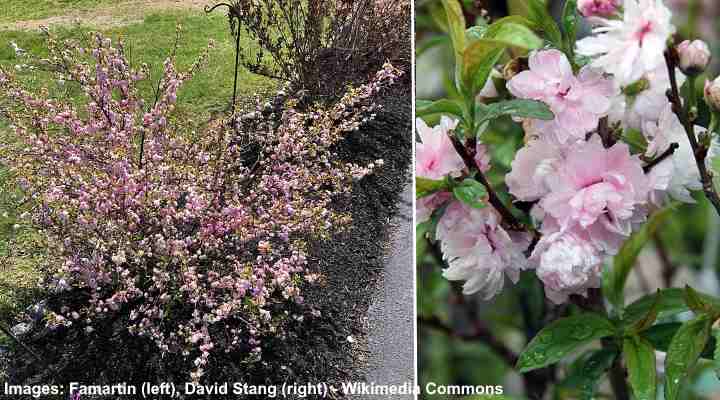
The Chinese plum tree is a dwarf pink-flowering ornamental shrub or small tree. Also known as the flowering almond, this small deciduous shrub-like tree produces beautiful clusters of pinkish-white flowers. Blooming in early spring before the leaves emerge, the cherry-like double flowers create a stunning display of pink blossoms. The tree’s green oval leaves turn an unimpressive yellow in the fall.
Chinese plum trees are easy to grow and can tolerate a variety of soils. However, good soil drainage is crucial. The most common use for the dwarf flowering almond tree is as an ornamental tree in front or backyards. They add beauty and fragrance as a focal point to any landscape.
Mature Size: 4 to 5 ft. (1.2 – 1.5 m) tall and wide
USDA Hardiness Zones: 4 to 8
Sun: Full sun to partial shade
Purple Leaf Plum ‘Nigra’ (Prunus cerasifera ‘Nigra’)
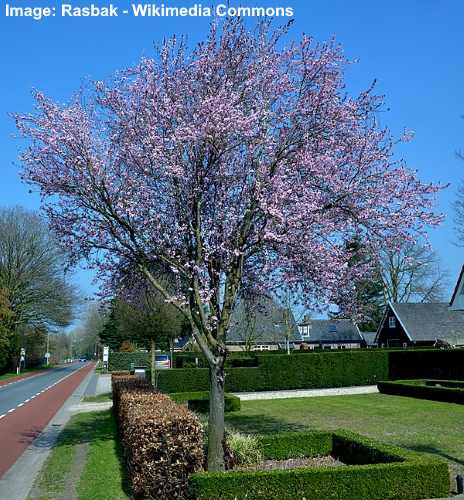
The purple leaf plum ‘Nigra’ creates a striking presence in gardens thanks to its delicate pink flowers and dark purple leaves. Deep pink flower buds, dark purple leaves, and fragrant star-shaped pink flowers identify this pink-flowering tree. The purple leaves are some of the darkest of any variety of plum trees.
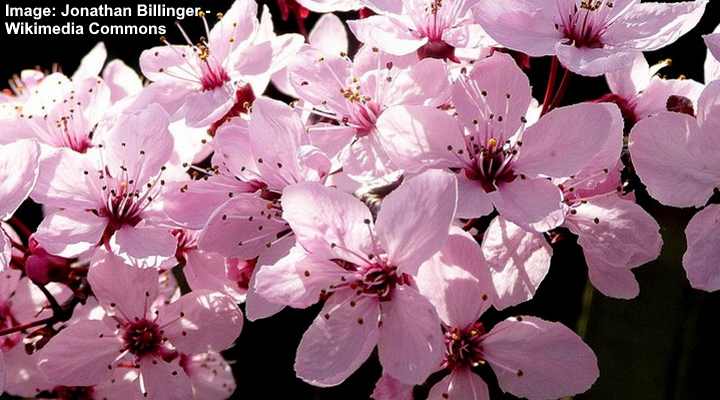
A close picture Prunus cerasifera ‘Nigra’ flowers
The purple-leaf plum ‘Nigra’ is a versatile tree that thrives in moderately fertile, well-draining soils. Thanks to its low height and compact size, you can plant the tree in small gardens as a specimen plant, flowering hedge, or privacy screen.
Mature Size: 15 to 20 ft. (4.5 – 6 m) tall and wide
USDA Hardiness Zones: 4 to 9
Sun: Full sun produces the darkest foliage colors
Silk Tree (Albizia julibrissin)
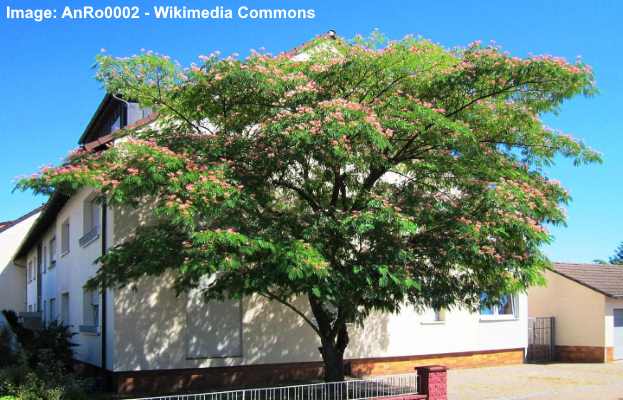
Also known as the mimosa tree, the silk tree is easily recognizable by its pink, fluffy, powderpuff flowers. The unusual pink flowers, with their long delicate stamens, appear in early summer, covering the tree in fluffy blooms. Another identifying feature is the tree’s fern-like leaves that fold at night or when you touch them.
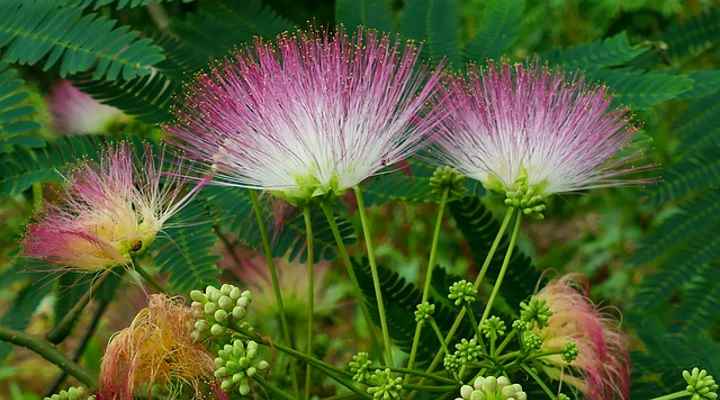
A close up picture of silk tree flowers
Silk trees are relatively low-maintenance and tolerant of drought, heat, and salt spray. The ornamental trees perform well in coastal gardens or add an exotic touch to a semi-tropical landscape. The silk tree’s unique flowers and foliage make it stand out in any garden.
Mature Size: 20 to 40 ft. (6 – 12 m) tall and wide
USDA Hardiness Zones: 6 to 9
Sun: Full sun
Common Smoke tree (Cotinus coggygria)
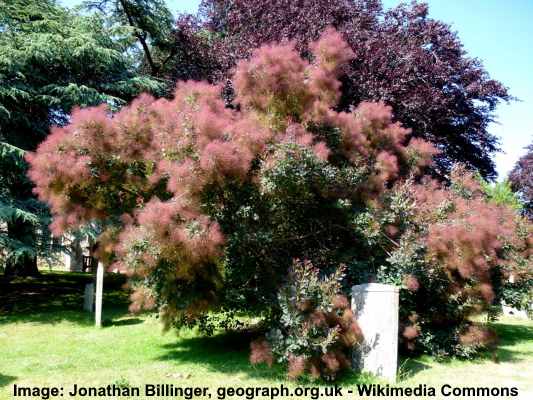
The common smoke tree is a deciduous ornamental tree with eye-catching clusters of purple-pink flowers. Summer-blooming, the distinct pink flowers have wispy filaments, giving them an airy, smoky appearance. The tree’s fall foliage color is reddish-purple.
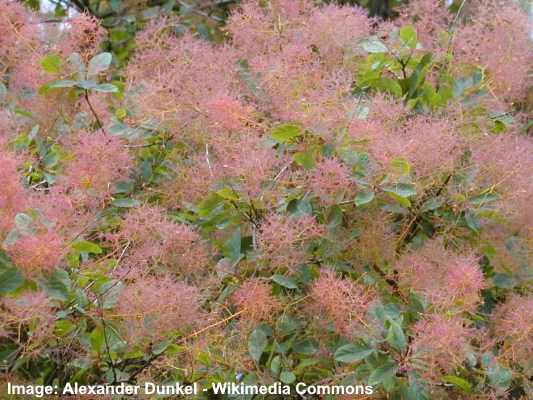
Smoke tree flowers
Varieties of smoke trees are cold-hardy large plants that thrive in USDA zones 4 through 9. Smoke trees tend to perform best in full sun to partial shade, which helps maintain their vibrant foliage.
You can plant smoke trees as flowering hedges, screens, or specimen trees.
Mature Size: 10 to 15 ft. (3 – 4.5 m) tall and wide
USDA Hardiness Zones: 4 to 8
Sun: Full sun or partial shade
Pink-Flowering Frangipani Trees (Plumeria)

Plumeria rubra tree and flowers
The tropical pink-flowering frangipani is a small tree with tropical pink star-shaped fragrant flowers with distinctive overlapping petals. The other identifying feature of frangipani trees is spatula-shaped leathery leaves. Pink-flowering frangipani trees thrive in tropical climates and prefer full sun.
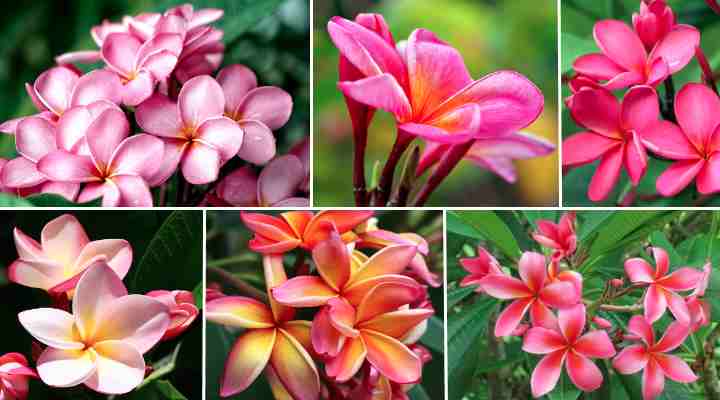
Pink plumeria flowers vary in shade depending on the cultivar
Here are some varieties of pink-flowering frangipani trees with a description of their flowers:
Plumeria rubra – A spreading tropical tree with dark pink flowers. Grows to 26 ft. (8 m) high and wide.
Plumeria ‘Pink Pansy’: Vibrant pale pink flowers with a darker pink margin and sweet fragrance.
Plumeria ‘Pink Lace’: The soft pink flowers have a distinct star shape and vibrant pink colors.
Plumeria ‘Pink Lemonade’: Thick, waxy petals have various shades of pink.
Plumeria ‘Pink Delight’: The pink flowers have a hint of yellow in the center and emit a strong, sweet fragrance.
Plumeria ‘Amorous Cloud’: This frangipani variety has large, pastel pink flowers with petals that have turned-in margins.
Mature Size: 15 to 25 ft. (4.5 – 7.6 m) tall and wide
USDA Hardiness Zones: 10 to 12
Sun: Full sun
Pink-Flowering Fringe Trees (Loropetalum chinense var rubrum ‘Sizzling Pink’)
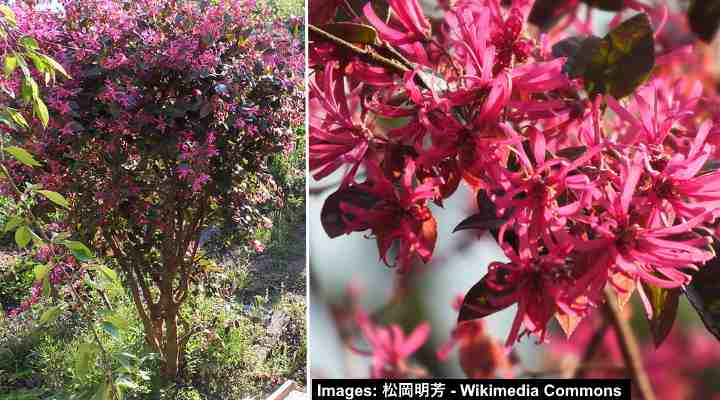
The pink-flowering fringe tree has spectacular flowers of slender, wiry deep pink petals. The fringe flowers bloom in late spring and give off a sweet fragrance. The dwarf shrub-like trees have dark, purplish leaves, adding to their dramatic beauty. The fringe tree performs well in foundation planting, small groups, and containers growing in well-drained soils.
Mature Size: 6 to 8 ft. (1.8 – 2.4 m) tall and wide
USDA Hardiness Zones: 7 to 9
Sun: Full sun to partial shade
Floss Silk Tree (Ceiba speciosa)
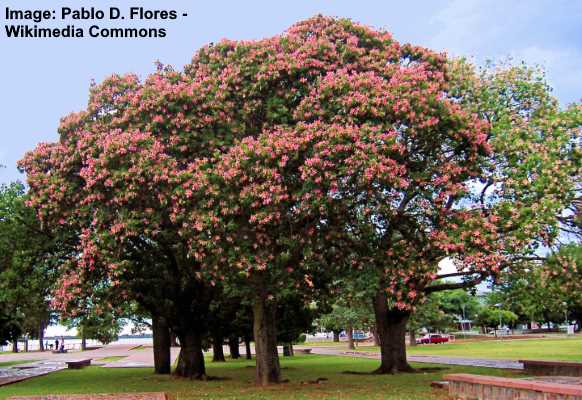
The floss silk tree blooms throughout the year with showy pink hibiscus-like flowers. Its flowers have five magenta-pink petals with wavy margins and a protruding stamen. The tree’s dark green palmate leaves turn yellow in the fall. Its fruits are pear-shaped and contain pea-like seeds covered in silky floss.

Ceiba speciosa flowers and leaves
Floss silk trees are known for their unique trunk, covered in sharp spines. The trunk also has a smooth, grayish-brown bark. Because of its jagged trunk, you should take care where to plant it.
Mature Size: 35 to 50 ft. (10 – 15 m) tall and 40 to 55 ft. (12 – 17 m) wide
USDA Hardiness Zones: 9 to 11
Sun: Full sun
Pink Shower Tree (Cassia grandis)
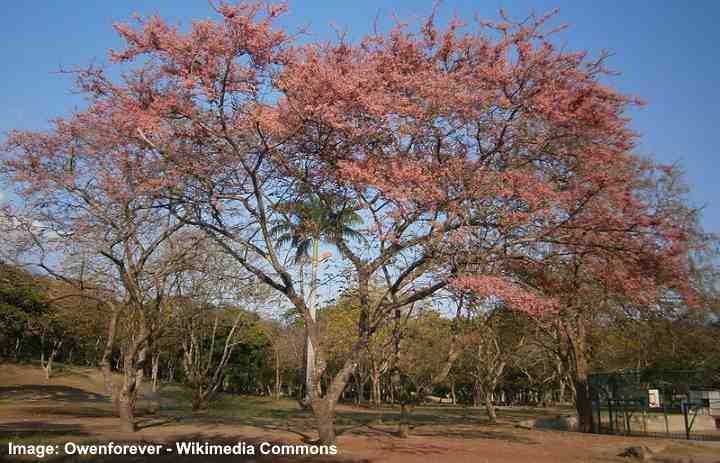
The pink shower tree is a tropical deciduous pink-flowering tree. Clusters of beautiful pink flowers, attractive pinnate leaves, and long bean-like seed pods grace the tree. The lush tree’s foliage is useful as a shade tree, and the attractive pink whitish flowers add an exotic feel to landscapes.
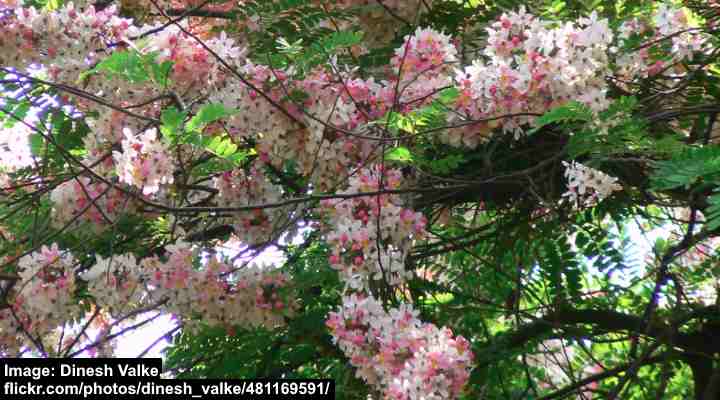
Pink shower tree flowers
Mature Size: 40 to 60 ft. (12 – 18 m) tall and wide
USDA Hardiness Zones: 10 to 12
Sun: Full sun to partial sun
Rose Laurel (Nerium oleander)

Rose laurel is a versatile small evergreen tree that blooms in summer with clusters of fragrant purple, white, or pink trumpet-shaped flowers. The tree’s foliage consists of long, narrow, glossy green leaves. This drought-tolerant tropical tree thrives in various types of well-drained soils.
You can grow rose laurel as a hedge, privacy screen, or specimen plant in gardens and landscapes.
It’s important to note that all parts of the rose laurel plant are toxic. So, it would be best to be careful when planting it to avoid children or pets encountering it.
Mature Size: up to 13 ft. (4 m) tall and wide
USDA Hardiness Zones: 8 to 10
Sun: Full sun or partial shade
Japanese Snowbell ‘Pink Chimes’ (Styrax japonicus ‘Pink Chimes’)

The Japanese snowbell’ Pink Chimes’ is a deciduous ornamental tree known for its beautiful pinkish-white flowers. This cultivar has delicate bell-shaped summer flowers hanging from weeping branches. Its oblong, glossy, dark green leaves turn yellow or red in the fall.
Japanese snowbell ‘Pink Chimes’ trees prefer acidic, humus-rich, well-drained soils with medium moisture. The trees perform well in containers and as specimen trees or lawn trees.
Mature Size: 15 to 20 ft. (4.5 – 6 m) tall and wide
USDA Hardiness Zones: 5 to 8
Sun: Partial shade
Royal Empress Tree (Paulownia tomentosa)
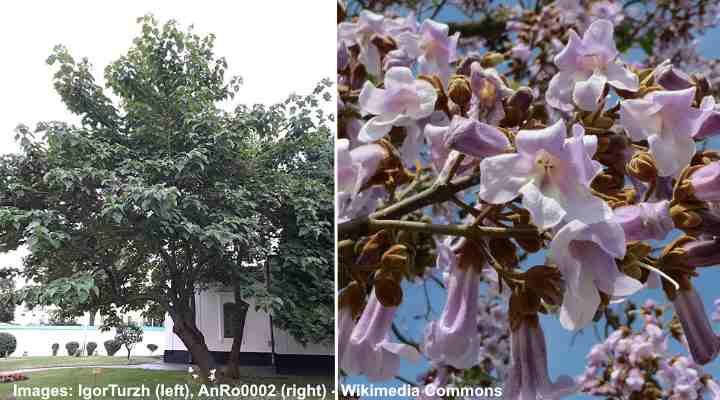
The royal empress tree is known for its clusters of fragrant, pale pink to lavender bell-shaped flowers. This fast-growing deciduous tree has large, heart-shaped leaves with five lobes. This impressive royal empress tree is adaptable to a variety of soil types and can tolerate drought conditions once established.
Landscaping uses for the royal empress tree include shade trees or ornamental trees in larger landscapes or parks.
Mature Size: 30 to 80 ft. (10 – 25 m) tall
USDA Hardiness Zones: 5 to 9
Sun: Full sun or dappled shade
Pink Chitalpa (Chitalpa tashkentensis ‘Pink Dawn’)

The Chitalpa tree is a fast-growing deciduous tree prized for its showy clusters of pink to white trumpet-shaped flowers. Beautiful orchid-like flowers bloom from summer through fall, attracting butterflies and hummingbirds. The tree has glossy green leaves that turn yellow and drop in the fall, revealing grayish-white bark.
Chitalpa trees are perfect summer flowering trees for small and compact backyards. It also works well near patios to provide shade.
Mature Size: 20 to 35 ft. (6 – 10 m) tall and wide
USDA Hardiness Zones: 6 to 11
Sun: Full sun to partial shade
Pink Powderpuff Tree (Calliandra haematocephala)
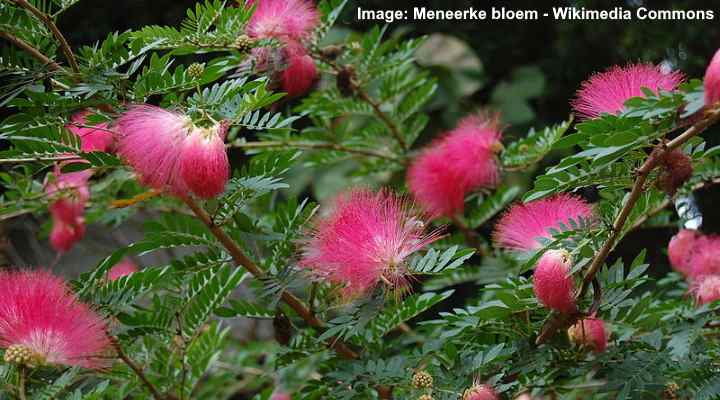
The pink powderpuff tree is a tropical flowering shrub-like tree with masses of vibrant dark pink puffball-like flowers. The pink to red puffball flowers consist of numerous stamens, making them look fuzzy. The tree’s small, feathery leaves add to its overall delicate and graceful appearance.
Pink powderpuff trees are native to Florida and look spectacular as ornamental trees in gardens. The vibrantly colored fluffy flowers add a pop of color and beauty to summer landscapes.
Mature Size: 10 to 15 ft. (3 – 4.5 m) tall and wide
USDA Hardiness Zones: 9 to 11
Sun: Full sun
Pink flowering Rose of Sharon (Hibiscus syriacus)
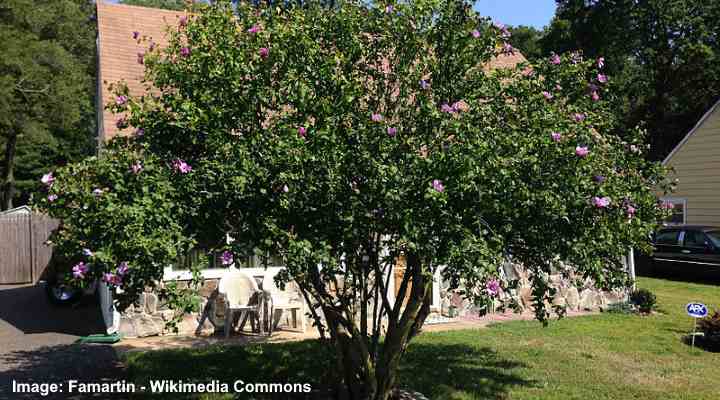
The Rose of Sharon, is a hardy shrub that can also grow as a deciduous tree in northern climates. Its most notable feature is its stunning flowers, which grace gardens with vibrant hues of pink, lavender, or magenta during the summer months. Depending on the cultivar, some Rose of Sharon flowers are single while others boast double blooms.

Rose of Sharon single and double bloom
The multi-stemmed shrub-like tree can be trained to grow as a tree with a single trunk. Although best growing in the ground, smaller hibiscus trees can grow in pots.
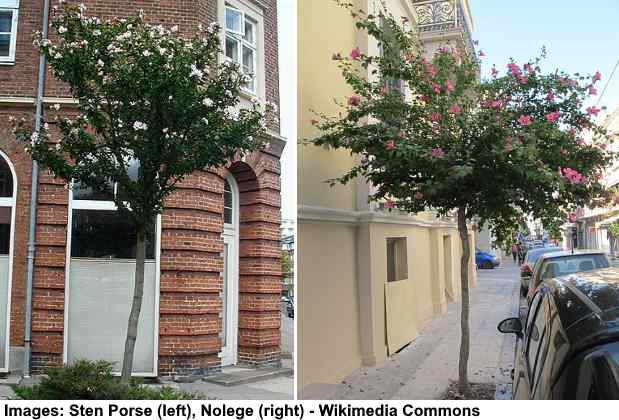
Single trunked Hibiscus syriacus trees
Plant the large shrub-like Rose of Sharon tree in well-draining soil that is always moist. Water hibiscus trees regularly in summer to keep them blooming. Ensure the trees grow in full sun where they get at least six hours of sunshine daily.
Mature Size: 8 – 12 ft. (2.4 – 3.6 m) height and 6 – 10 ft. (1.8 – 3 m) wide
USDA Hardiness Zones: 5 to 8
Sun: Full sun
Discover many other types of flowering trees in a variety of colors.
Related articles:
